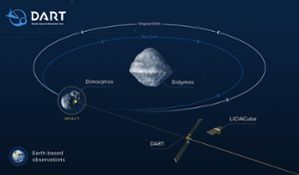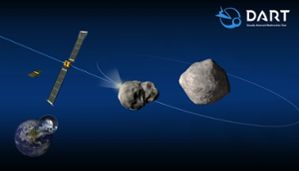When fiction and real life collide: MSU's role in planetary defense
On December 10, Netflix will debut the movie “Don’t Look Up,” a fictional comedy about Michigan State University researchers who try to warn the government about a giant asteroid’s impending collision with Earth. In the story, no one from the government or press is paying attention, but in real life, NASA and MSU are very much engaged in the serious and important science of planetary defense.

The Double Asteroid Redirection Test, or DART is the world’s first full-scale planetary defense test, demonstrating one method of asteroid deflection technology. Planetary scientist Seth Jacobson, from the Department of Earth and Environmental Sciences in the MSU College of Natural Science (NatSci), is part of a multi-disciplinary research team working on this project.
Jacobson started researching binary asteroids over a decade ago.
“My Ph.D. thesis was all about binary asteroids and what they could tell us about the properties of small bodies in the solar system,” he said. “I got involved with this project because I was very curious about the long-term evolution of this binary asteroid system and what we could learn about the interior of the asteroid through the deflection.”
An on-orbit demonstration of asteroid deflection is a key test that NASA and other agencies wish to perform before any actual need is present. The DART mission is NASA's demonstration of kinetic impactor technology, impacting an asteroid to adjust its speed and path. DART will be the first-ever space mission to demonstrate asteroid deflection by kinetic impactor. Launch is planned for November 2021 and impact is expected to take place in Fall of 2022

DART's target is the binary asteroid system Didymos (diameter: 780 meters, 0.5 miles), which means "twin" in Greek, so named because it has a moon called Dimorphos (diameter: 160 meters, 0.1 miles). The DART spacecraft will impact Dimorphos nearly head-on, shortening the time it takes the moonlet to orbit Didymos by several minutes. Although it is not on a path to collide with Earth and therefore poses no actual threat to the planet, the binary system is ideal for measuring the orbital deflection of the small asteroid moonlet.
“The idea is similar to a collision between billiard balls,” Jacobson explained. “You have a ball on a trajectory, and you're going to try and strike it in such a way that it no longer follows its old trajectory. But in the case of asteroids, it's not just mechanical properties that matter. Gravity plays a role in how the object organizes its shape and internal structure. The moonlet isn’t a hard, rigid, ceramic ball like in billiards. Instead, it has this deformable granular media structure where it behaves almost as a fluid on large scales, while still being solid on small scales. Because of that, we just don't know how the DART impactor is going to interact with that material and deflect the asteroid.”
Jacobson is part of the DART team’s Dynamics Working Group, which is being led by Derrick Richardson at the University of Maryland. They study the long-term past and future evolution of the Didymos binary asteroid system as well as the details of measuring the all-important momentum transfer efficiency—the effectiveness of the trajectory deflection due to the impact.
“Our team models what happens to the asteroid and the binary dynamics prior and post the collision, so we determine what beta is.” Jacobson said. “When we do numerical computer simulations, we get a variety of answers and nobody knows which simulations are correct because we've never done the actual experiment. The experimental data is also really interesting from a geophysics perspective, because we will learn about the interior of these objects and their history in the solar system.”

The DART Impactor, which will navigate to crash itself into Dimorphos at a speed of approximately 6.6 kilometers (4.1 miles) per second, is just one major component involved in the mission. DART will also carry a CubeSat contributed by Agenzia Spaziale Italiana (ASI), named LICIACube (Light Italian CubeSat for Imaging of Asteroids). The DART spacecraft will deploy LICIACube roughly ten days prior to the DART impact on Dimorphos. LICIACube will capture images of the DART impact, the resulting ejecta cloud, and potentially a glimpse of the impact crater on the surface of Dimorphos.
Jacobson explained the personal value of applying a geoscience lens to the project.
“First, since my first work on binary asteroids as a graduate student, I have gained a much deeper understanding of geophysics,” he said. “My understanding of how the interiors of these bodies work, how they deform due to stresses and transmit stresses through seismic waves has really been informed by my transition into the geosciences. Second, I’ve become much more interested in the history of the solar system. Now I see this connection between asteroid evolution to meteorites and to our record of the whole solar system.”
Even though the main objective of the mission is planetary defense, Jacobson sees a larger scientific benefit.
“These binary asteroids are interesting little worlds that have moons and change with time,” he said. “And there's a lot of really interesting physics that takes place in and around them. They're really crucial for understanding the history of the solar system, and so we need to understand that physics to ultimately unlock our own past, the deep past of humanity.”
Banner image: Illustration of DART, from behind the NEXT–C ion engine. Credit: NASA/Johns Hopkins APL